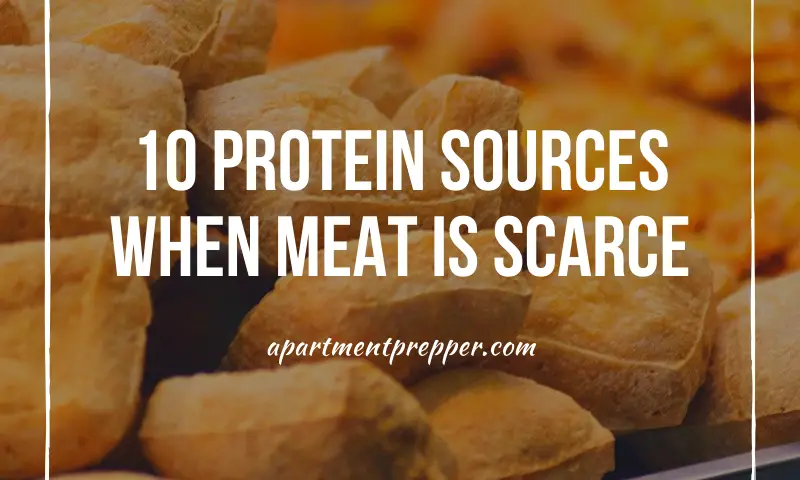This post is by Bernie Carr, apartmentprepper.com
At my last grocery shopping trip, I noticed that meat has gotten very expensive, and in some cases hard to find. Many meat processing plants have shut down due to workers becoming ill from COVID-19, causing a meat shortage. Hopefully, this is a temporary situation, but in the meantime, we all have to cope with the high prices of meat.
We already know we can always use less meat, buy cheaper cuts or even stretch ground beef. But what about alternative protein sources? In this article, let’s take a look.
Eggs
Eggs are an excellent source of protein, not to mention, very tasty. I can eat eggs for any meal; I like eating breakfast for dinner. A large egg contains six grams of protein: three grams in the yolk and three grams in the white. Eggs also contain vitamin B12, riboflavin, phosphorus and selenium. They do contain cholesterol so you need to be mindful of that if you are watching your cholesterol intake.
Milk
A cup of milk contains eight grams of protein. If you are lactose intolerant, try almond milk and other nut milks.
Yogurt
One cup of whole milk yogurt contains eight eight and a half grams of protein. Yogurt is also good source of vitamins, minerals and probiotics. It’s even easy to make your own!
Tofu
Tofu is a nutrient-dense food, containing protein, amino acids and a variety of vitamins and minerals. One three and a half ounce serving contains eight grams of protein. One common complaint about tofu is that it is bland. One way to add flavor to tofu is by marinating – just mix two tablespoons of soy sauce with a teaspoon of sugar, some pepper, ginger and garlic powder. Slice the tofu into squares and marinate it overnight. To cook, just stir fry with some vegetables or deep fry in oil.
Nuts
Nuts are a great source of protein. They contain around five to six grams of protein per ounce. However, keep in mind they are also high in fat, so a little goes a long way. You can also try nut butters such as peanut butter (as long as no one has an allergy), almond or cashew butter.
Beans
I always recommend storing beans as they are a great source of protein. Store your favorites such as pinto, kidney or black beans. Cooking beans is easy. Soak two cups of beans overnight. The next day, boil for about an hour until they soften. Do not add salt until they are cooked. Season with garlic and onion powder. Serve with rice.
Lentils
Lentils are part of the same legume family as beans however, unlike beans they do not require a pre-soaking and cook very quickly. They also contain more fiber than beans. A half cup of lentils contain eight grams of protein.
A lot of people buy lentils with the best intentions and the bag ends up sitting in the pantry uneaten. To avoid that, check out a few recipes and resolve to try them out.
Quinoa
Quinoa is a South American grain that contains a lot of protein: a cup contains eight grams of protein. It contains amino acids, iron, magnesium, manganese and it is rich in fiber. I like to cook it in chicken broth or water – combine one cup of quinoa and two cups of water. Allow to boil and simmer for 15 minutes.
Protein powder/meal replacement shakes
I’ve always thought that meal replacement or protein shakes are a good addition to food storage.
Many of them have a long shelf life. Try a single serving or a small size before you buy in bulk so you don’t waste your money if you don’t like the taste.
Fish
If meat is too expensive, change your diet to include fish. A lot of people think fish is even more expensive than beef, but that is not necessarily true. You can also buy canned tuna or sardines.
I know there are more sources that we can name, but I included the ones I use the most frequently. Earlier this year we even looked at cricket bars, but since I don’t have them in my kitchen, I did not include then on the list.
What are your favorite protein alternatives? Please share in the comments!
*******************************************************************************
We are an affiliate of Amazon.com, which means we received a small commission if you click through one of our Amazon links when you shop, at totally no cost to you. This helps keep the lights on at the blog. Thanks!
About the author:
Bernie Carr is the founder of Apartment Prepper. She has written several books including the best-selling Prepper’s Pocket Guide, Jake and Miller’s Big Adventure, The Penny-Pinching Prepper and How to Prepare for Most Emergencies on a $50 a Month Budget. Her work appears in sites such as the Allstate Blog and Clark.com, as well as print magazines such as Backwoods Survival Guide and Prepper Survival Guide. She has been featured in national publications such as Fox Business and Popular Mechanics. Learn more about Bernie here.
Image by Peter Chou from Pixabay



